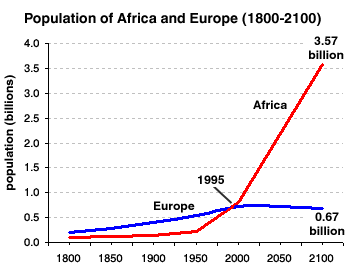The governments of Europe are confronting an epochal choice in the Mediterranean. Do they allow Europe to remain on course toward inundation by the African population explosion, inevitably turning Florence into Ferguson and Barcelona into Baltimore?
The conventional wisdom is that it’s unthinkable to stop the African tsunami. Veteran public radio correspondent Sylvia Poggioli assured gullible NPR listeners on Monday:
This is a human tide that cannot be stopped,” she says. … Europeans have to start providing legal channels that will allow them to seek asylum here. This is a humanitarian crisis, says Mascena, that cannot be solved by use of force — or by leaving these desperate human beings bottled up in Africa and the Middle East.
Or will Europeans adopt the sensible policies of Australia and Israel that have succeeded at turning back
Camp of the Saints-style invasions by boat?
The Sub-Saharan African population bomb is the most obvious long-term problem facing global peace and prosperity. We’ve been lectured for decades about climate change, but the staggering fertility rates among black Africans have been largely hushed up over the last quarter of a century. We’re supposed to assume the problem will solve itself without any white people ever being so crass as to mention that it’s even a problem.
While birth rates have dropped in much of the world, they remain staggeringly high in much of Africa south of the Sahara. The simplest measure to work with is the
total fertility rate, a projection of babies per woman per lifetime. While many countries have dropped below the replacement rate (for example, Iran is at 1.85), there are 35 countries in black Africa with total fertility rates over 4.0, compared to only four elsewhere on earth.
The highest TFR is seen in desert Niger at 6.89 babies per woman. You could argue that Niger in the southern Sahara is an unimportant wasteland, with only 8 million people back. (Oh, wait, that was back in 1990. Now it’s up to 18 million.)
Even more worrisome are giant Nigeria (177 million people) at a TFR of 5.25, Ethiopia (97 million) at 5.23, and the Democratic Republic of the Congo (77 million) at 4.80...
...two years ago the United Nations Population Division released a shocking update to their population projections, revising the forecast for the continent of Africa upward to 4.2 billion in 2100 from 1.1 billion today...
Africa is almost certainly not going to add over three billion residents over the next 85 years. Something else will happen instead, ideally a decline in African fertility to sustainable levels rather than mass migrations or a rise in the death rate.
Africans will attempt to decamp en masse to Europe and to other first world countries, such as America.
If Africans aren’t allowed to get away with that, however, they might actually deal with their own fertility excesses, just as almost everybody else outside Africa has more or less done...
CAIRCO Notes
This is a prime example of
r/k selection theory as applied to human population subgroups - that is, the tradeoff between quantity and quality of offspring. From Wikipedia:
In ecology, r/K selection theory relates to the selection of combinations of traits in an organism that trade off between quantity and quality of offspring. The focus upon either increased quantity of offspring at the expense of individual parental investment, or reduced quantity of offspring with a corresponding increased parental investment, varies widely, seemingly to promote success in particular environments.
The etymology is from an equation where r comes from rate and K comes from carrying capacity.
Examples of Extreme R-strategists Many r-selected species tend to be opportunists, meaning that they reproduce and disperse rapidly when conditions are favorable or when a disturbance opens up a new habitat or niche for invasion. This could occur in the early stages of ecological succession. Once their populations are established, their populations may crash due to changing or unfavorable environmental conditions or invasion by more competitive species. Because of this, most r-selected species go through irregular and unstable boom-burst cycles in their population size. In order to survive, these r-selected species must continually invade new areas to compensate for being displaced by more competitive species. - includes most larger animals.
Niger Is a Transit Point for Thousands of Africans Headed North, Limits to Growth, May 1, 2015
Population momentum explained:
Population momentum is the tendency for population growth to continue beyond the time that replacement-level fertility has been achieved because of the relatively high concentration of people in the childbearing years. It takes a period of time equal to the average life expectancy (approximately three generations or 73 years in the U.S.) for a reduction in fertility to be manifested as a change in actual population numbers. See additional information on fertility and population momentum. Also see this short discussion of population momentum, and Population Terms and Definitions.
The Camp of the Saints, by Jean Raspail, Translated by Norman Shapiro
Originally published in France, The Camp of the Saints has been described as the 1984 of the late twentieth century. The Social Contract Press is pleased to be able to offer a reprint of this gripping novel, which envisions the overrunning of European civilization by burgeoning Third World populations. (softcover, 316 pages)
Camp of the Stupids, by John Derbyshire, Taki's Magazine, April 23, 2015
Refugee Resettlement

